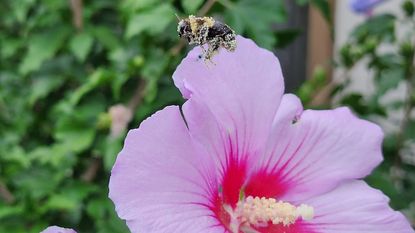The Flowers That Draw All The Bees


Pollinators are so important, especially with the crisis hitting bees in recent years. My garden has several plants that draw in bees and other pollinators, but year after year, the one they seem to love the most is my large rose of Sharon.
About Rose of Sharon
Rose of Sharon (Hibiscus syriacus) is a large shrub and a type of hibiscus. It can also be pruned to a tree form. In good conditions, it will grow up to 12 feet (3.6 m.) tall.
The flowers are often a few inches across (7-8 cm.) and come in a few different colors. I have one with pink flowers and another with pure white blooms. The stamen in the center is prominent and the petals often have a contrasting color toward the center. Some plants have double blooms.
Rose of Sharon and Pollinators
Pollinators love this plant. The big, showy flowers have large stamens that draw in a lot of bees. My two shrubs get so many bees in the summer that it sounds like the plants are buzzing.
Hummingbirds also like these flowers, so I often see one or two darting in between all the bees. The bees that seem to like Rose of Sharon the most are bumble bees, my personal favorite. I love to watch these fat, fuzzy bees get loaded up with pollen as they go from flower to flower.
How to Get More Blooms
In addition to the pretty flowers and the abundance of pollinators, what I love about rose of Sharon is how easy it is to grow. It tolerates heat, air pollution and to some extent, drought.
Although it is low maintenance and tolerant of poor conditions, you'll get more flowers and more pollinators with good care of your rose of Sharon. It prefers moist, well-drained, and fertile soil. Make sure it gets plenty of sun and provide water during drought conditions.
Gardening tips, videos, info and more delivered right to your inbox!
Sign up for the Gardening Know How newsletter today and receive a free download of our most popular eBook "How to Grow Delicious Tomatoes."
A good spring pruning helps promote more blooms too. Early spring is the best time to do it, but make sure you don't prune away new growth, since this is where the flowers develop. Time the pruning session before new growth appears, or just take care to only prune back older branches.
Pests can be an issue with rose of Sharon. Keep an eye out for aphids and give the leaves and flower buds a good blast of water to remove any you see. They can damage buds and prevent them opening. I have also had an issue with Japanese beetles on my shrubs. I pick them off or use the hose to remove them.
With good care, rose of Sharon will give you consistent flowers, from June through early fall. They'll draw in more pollinators than most other plants in your garden.

Mary Ellen Ellis has been gardening for over 20 years. With degrees in Chemistry and Biology, Mary Ellen's specialties are flowers, native plants, and herbs.
-
 Clever Vertical Vegetable Garden Ideas For Small Spaces – 7 Ways To Save Space
Clever Vertical Vegetable Garden Ideas For Small Spaces – 7 Ways To Save SpaceShort on garden space? Learn some vegetable garden ideas for small spaces that are fun and easy.
By Mary Ellen Ellis
-
 26 Different Types Of Orchids – With Pictures & Information
26 Different Types Of Orchids – With Pictures & InformationDiscover stunning orchid types to grow in your home and garden – from easy beginner varieties to rare and exotic species that are the preserve of experts.
By Melanie Griffiths